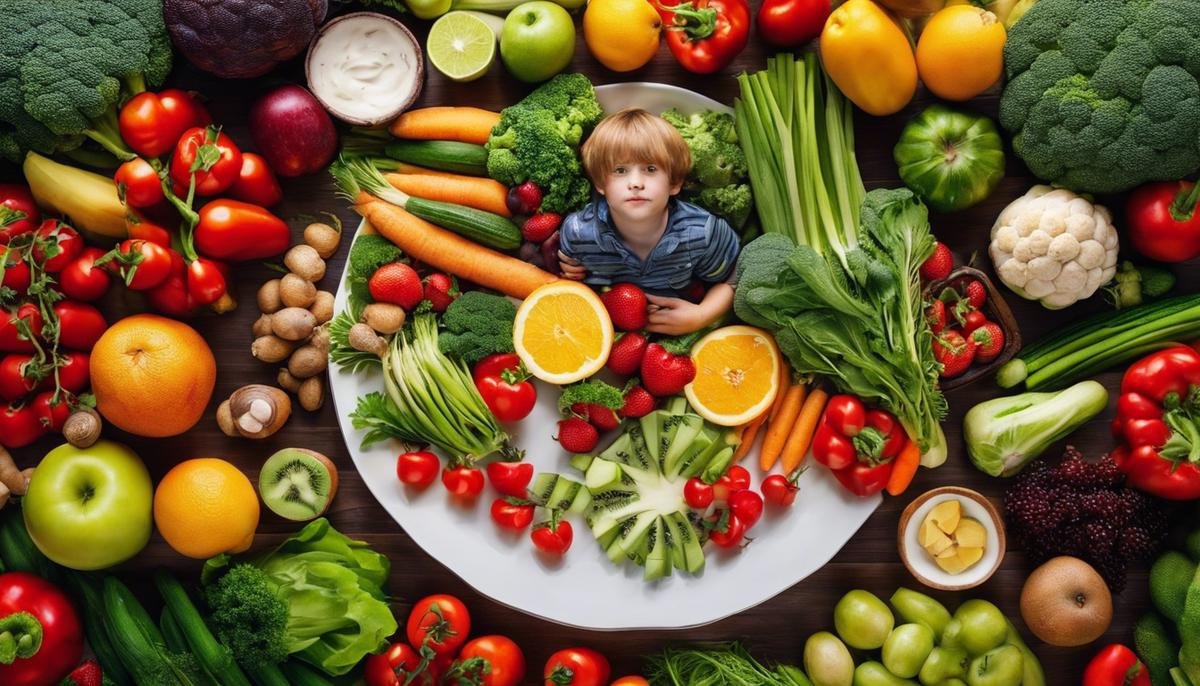
Autism spectrum disorder (ASD) touches the lives of many, presenting unique challenges and wonders alike. Among the myriad of considerations families navigate, understanding the dietary needs associated with autism is pivotal. Sensory sensitivities, gastrointestinal issues, and the quest for a balanced diet often intertwine, creating a complex mosaic that requires careful attention and thoughtful action. As we delve into the impact of ASD on eating habits, we uncover strategies to nurture health and wellbeing through nutrition. Furthermore, the intricate relationship between processed foods and behavioral changes becomes a crucial aspect of this exploration, shedding light on the profound influence diet can wield.
Understanding Autism and Dietary Needs
Navigating Dietary Choices for Children with Autism: Understanding and Support
When you’re raising a child with autism, every aspect of life can hold unique challenges and surprises–and mealtime is no exception. There’s a heartwarming connection that happens around the dinner table, but it can sometimes be disrupted by the dietary issues often associated with autism. Not to worry, though! With a little insight and patience, families can ensure their loved ones with autism receive the nutrition they need while embracing the joys of eating together.
Children with autism might face a variety of dietary concerns, such as food selectivity or sensitivities. These kiddos may have a limited palette, favoring only certain textures or colors. It isn’t just a stubborn refusal of brussels sprouts but a genuine reaction to the sensory properties of food which can be overwhelming for them. Remember, if a child with autism insists on eating pasta every night, it’s not to push buttons, it’s comfort in consistency and familiarity.
It’s also not uncommon for children on the spectrum to have gastrointestinal (GI) issues, like constipation or diarrhea, that influence what they can tolerate eating. It’s always a good idea to keep a food diary to help spot any patterns and identify foods that might be causing tummy trouble. This kind of proactive approach does wonders for tailoring a diet that can alleviate some of these daily discomforts.
So, what can loving family members and caregivers do to support the dietary needs of their beloved child on the autism spectrum? Here are a few tried-and-true tips:
- Create a safe space for exploration by introducing new foods slowly and without pressure. Pairing the unfamiliar with the familiar can be a win. It’s like dipping a toe in water before jumping in!
- Texture is often just as important as taste. Be mindful of this when preparing meals. If crunchy carrots are a no-go, maybe mashed sweet potatoes will be a hit.
- Visuals help a lot! Sometimes, showing a picture of a new food or explaining it can make the food less daunting. Think of it as a ‘before-you-taste’ sneak peek.
- Nutrition doesn’t have to be compromised. There are fantastic supplements and nutrient-dense foods that cater to selective eaters. Even small additions, like a sprinkle of flaxseed here or a dash of nutritional yeast there, can go a long way.
- Offering a sense of control can empower children with autism. Let them have a choice (even if it’s a choice between two parent-approved options). Sometimes, meal planning can be a family affair.
- Keeping mealtime routines can offer the comfort of stability, so try to keep schedules consistent and reduce unexpected changes.
At the heart of it all, patience is key. Food preferences may evolve over time, and that’s okay. The journey of raising a child with autism is unique and often calls for a special blend of perseverance and creativity.
Remember, you’re not alone in this. The incredible community of parents and experts online and in real life is a treasure trove of shared experiences and support. And together, navigating dietary choices will become one more way to celebrate the individuality and growth of the amazing child at your table. Cheers to happy, healthy family mealtimes!

The Impact of Processed Foods on Behavior
Navigating the Grocery Aisles: Processed Foods and Autism Behavior
As parents, we all want the very best for our kids, and when we’re raising a child with autism, our vigilance around their health and well-being, including their nutrition and eating habits, becomes even more front and center. While we’ve established a solid ground on understanding the nuances of food sensitivities and the impact of sensory properties on our little ones with autism, there’s a pressing concern that often buzzes in parenting forums, playdates, and even pediatricians’ offices: Can processed foods affect the behavior of children with autism?
Before we dive into unpacking this question, let’s shine a light on processed foods. Sure, they’re convenient and often have a longer shelf life, but these foods can be packed with added sugars, artificial coloring, preservatives, and other additives. For neurotypical kids, these can sometimes pose a challenge, but for those on the autism spectrum, the effects might be amplified. It’s widely discussed in our community that children with autism can be extra sensitive to chemicals and ingredients found in processed foods.
The intricate connection between the gut and the brain is something that’s garnered quite a bit of attention in recent years. This gut-brain axis seems to be even more delicate in children with autism. When processed foods disrupt the gentle balance of gut flora, it can potentially exacerbate GI issues. More importantly, this disturbance can manifest through behavior – be it increased irritability, hyperactivity, or a change in mood. It’s not uncommon to hear stories about a parent who noticed significant behavior change after reducing the amount of processed foods in their child’s diet.
In looking at the bigger picture, it’s essential to consider not just what is being eaten, but how the overall diet can influence behavior. Certain food additives like artificial colors and preservatives have been linked to hyperactivity in some studies. While research is ongoing, and there’s no definitive answer for every child, many parents become watchful of the types of foods their children consume.
Another factor to consider is the nutritional content of processed foods. They often lack the vital nutrients that are essential for brain health and development. Essential fatty acids, antioxidants, vitamins, and minerals play a significant role in neurological function. If a child’s diet is heavy on processed foods, they might be missing out on these key nutrients.
So, what’s a parent to do? Opting for whole foods over processed with as little packaging as possible can be a great start. But don’t forget, any diet changes should be a gradual process, and it’s wise to involve a nutritionist or healthcare provider who understands the unique needs of children with autism.
The home kitchen can become a lab for experimenting with wholesome, less-processed meal options. Focus on fresh fruits, vegetables, lean proteins, and whole grains. Not only does this support a more balanced diet, but it could also help in identifying any food-related triggers that affect behavior.
The journey with food and autism is as much about what to add as it is about what to omit. Ensuring a diet rich in foods that naturally combat inflammation can be beneficial. This is where omega-3 fatty acids, found in fish and flaxseeds, as well as rich, colorful vegetables and fruits, come into play.
Lastly, let’s not underestimate the power of community wisdom. The vast network of families navigating autism together is an invaluable resource. Tap into this well of collective knowledge for recipes, strategies, and emotional support. It’s the shared stories and successes that often guide us best.
At the heart of it, we want to provide a loving environment for our children where they can thrive. When it comes to diet, this means continuously learning, adapting, and being open to new approaches that might benefit our extraordinary kids. So, let’s keep the conversation going, share our struggles and triumphs, and above all, celebrate the little victories at the dinner table and beyond.

Alternatives to Processed Foods
As families strive to adopt healthier eating habits, especially for children with dietary sensitivities like autism, finding practical alternatives to processed foods is crucial. Embracing whole, unprocessed foods can significantly benefit these children, leading to improved behavior and overall health.
Whole grains such as brown rice, quinoa, and oats are excellent staples for any pantry, providing necessary fiber and keeping meals hearty and satisfying. These can be used in various dishes, from oatmeal breakfasts to rice bowls and grain salads for lunch or dinner.
When it comes to proteins, lean meats like chicken, turkey, and fish are top choices. However, plant-based proteins like beans, lentils, tofu, and tempeh are not only nutritious but can also offer an array of textures and flavors that might appeal to children’s different sensory preferences.
Vegetables and fruits are the cornerstone of a nutrient-rich diet. They can be presented in fun shapes or paired with healthful dips to make them more appealing. For picky eaters, sneaking veggies into sauces, smoothies, or baked goods can ensure they’re getting their daily dose of vitamins without a fuss.
Snack time doesn’t have to rely on prepackaged goodies. Simple homemade alternatives, such as popped popcorn, sliced veggies, or a mix of nuts and dried fruits, can offer convenience without compromising nutritional quality. Creative presentation can play a significant role in making these healthier options more enticing.
Hydration is another essential aspect, and sugary drinks can easily be replaced with infused waters, herbal teas, or simply a squeeze of fresh fruit into plain water for a touch of flavor.
Lasty, don’t underestimate the power of herbs and spices. They not only pack a punch in terms of adding flavor without the need for preservatives or additives but can also contribute to a child’s overall health with their anti-inflammatory properties.
Involve the whole family in meal preparation, turning it into a bonding activity and an opportunity for children to become familiar with new foods in a hands-on way. The journey toward a diet centered around whole foods, especially for children with autism, might pose its challenges. Still, it’s also an adventure that can bring about lasting lifestyle improvements and a thriving community atmosphere.

Implementing Dietary Changes Gradually
Navigating through a sea of meal options for children can be daunting at times, but those challenges can multiply when it comes to children with autism, who might experience heightened sensitivity to tastes, textures, and smells. The journey toward a diet that’s not only nutritious but also appealing to a child with autism’s unique preferences requires something akin to a delicate dance – understanding, gradual changes, and a sprinkle of creativity.
Delving into the world of whole foods presents a fantastic opportunity to enhance overall well-being while potentially easing some behavioral concerns. As children thrive on routine, incorporating new whole foods should be as seamless and subtle as possible. A brilliant place to start is right at the breakfast table. Transition from commercial cereals to a warm bowl of oatmeal, jazzed up with their favorite fruits or a drizzle of honey, can be both comforting and a step towards less processed food consumption.
When it comes to main meals, the trick might be in presentation and participation. For example, create a make-your-own pizza night where children can choose from a range of healthy toppings, including freshly chopped veggies and grilled chicken. This approach can also be applied to tacos, with whole grain tortillas and a smorgasbord of fillings. Let the child wield a sense of control, which can reduce mealtime resistance.
Snack time doesn’t have to be lackluster or fraught with unhealthy choices. In fact, snacks are an incredible avenue to explore the bounty of whole foods. Try dehydrated fruit chips or crunchy kale chips instead of potato chips. Natural peanut butter on apple slices can be a hit, combining a familiar favorite with a twist.
As we know, hydration plays a key role in everyone’s health. One can swap out the fizzy drinks and sugary juices for naturally-flavored waters – think a pitcher of iced water with slices of cucumber, berries, or citrus. Not only does it look like a special concoction, but it’s also a fun way to hydrate without the added sugars.
Herbs and spices are powerful allies in the kitchen, offering bursts of flavor to any dish without the need for sodium or artificial additives. Experiment with different combinations, maybe starting with less intense herbs like basil or thyme, which can enhance a dish’s appeal without overwhelming the senses.
Yet, it’s not just about the food. It’s also about forging connections. Involving children with autism in meal preparation can provide a sense of accomplishment and a better understanding of what they are consuming. It’s a teaching moment, a therapeutic activity, and lets face it — it’s a lot of fun too!
In conclusion, the transformation to a wholesome, less processed food diet is a journey filled with opportunities for learning, bonding, and growing – within the kitchen and beyond. By respecting the child’s pace, being inventive with preparations, and keeping the process inclusive and enjoyable, parents can provide nourishing meals that fit their child’s needs without adding additional anxiety or stress to dining. Remember, change doesn’t happen overnight, but each little step taken is a victory in paving the path toward healthier lifestyle choices.

Embarking on the journey to modify dietary habits can seem daunting, especially within the realm of autism where routine and familiarity hold immense value. Yet, through incremental changes and a dash of creativity, it is possible to transform the panorama of mealtimes into an enriching experience for the whole family. It is the resilience, innovation, and shared celebrations in each small victory that build the path toward healthier eating and improved behaviors. As families continue to share their experiences and wisdom, a collective tapestry of success stories weaves into existence, guiding and inspiring those standing at the threshold of change.




